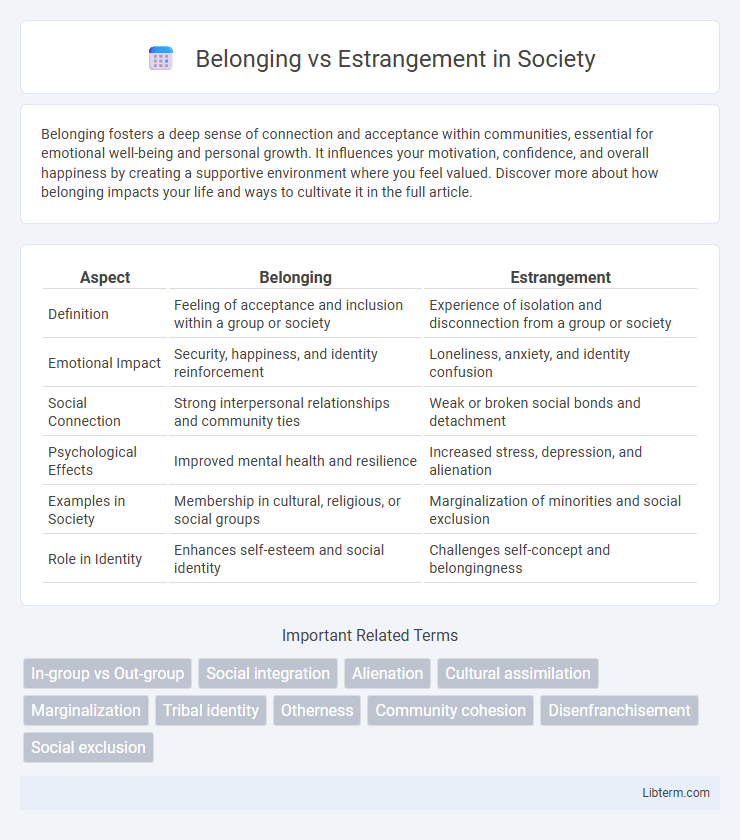Belonging fosters a deep sense of connection and acceptance within communities, essential for emotional well-being and personal growth. It influences your motivation, confidence, and overall happiness by creating a supportive environment where you feel valued. Discover more about how belonging impacts your life and ways to cultivate it in the full article.
Table of Comparison
| Aspect | Belonging | Estrangement |
|---|---|---|
| Definition | Feeling of acceptance and inclusion within a group or society | Experience of isolation and disconnection from a group or society |
| Emotional Impact | Security, happiness, and identity reinforcement | Loneliness, anxiety, and identity confusion |
| Social Connection | Strong interpersonal relationships and community ties | Weak or broken social bonds and detachment |
| Psychological Effects | Improved mental health and resilience | Increased stress, depression, and alienation |
| Examples in Society | Membership in cultural, religious, or social groups | Marginalization of minorities and social exclusion |
| Role in Identity | Enhances self-esteem and social identity | Challenges self-concept and belongingness |
Understanding Belonging and Estrangement
Understanding belonging involves recognizing the deep human need for connection, acceptance, and inclusion within social groups, which fosters identity and emotional well-being. Estrangement, in contrast, refers to the experience of alienation or disconnection from others, often resulting from conflicting values, social exclusion, or personal trauma. Exploring these states highlights the psychological impact of social bonds and the consequences of isolation on mental health.
Psychological Roots of Belonging
The psychological roots of belonging stem from humans' innate need for social connection, deeply embedded in the brain's reward system and attachment mechanisms. Neurochemical processes, such as the release of oxytocin, reinforce feelings of trust and safety within groups, fostering emotional security and identity formation. Conversely, estrangement arises when these fundamental needs are unmet, leading to feelings of isolation, anxiety, and diminished self-worth.
Causes and Manifestations of Estrangement
Estrangement often stems from unresolved conflicts, communication breakdowns, or conflicting values within relationships, leading to emotional distance and isolation. Manifestations of estrangement include reduced contact, avoidance behaviors, and feelings of loneliness or rejection. Understanding these causes and signs is crucial for addressing relational fractures and fostering potential reconciliation.
The Role of Culture in Shaping Connections
Culture profoundly influences the dynamics of belonging and estrangement by shaping shared values, traditions, and social norms that foster group identity. Cultural rituals and narratives create a sense of inclusion, while cultural differences or dissonance can lead to feelings of estrangement and isolation. Understanding these cultural frameworks is essential for bridging gaps and promoting meaningful connections across diverse communities.
Social Identity and Group Dynamics
Belonging and estrangement significantly influence social identity by shaping individuals' sense of self within group dynamics, where inclusion fosters positive self-concept and social cohesion. Social identity theory explains that group membership provides emotional support and social validation, reinforcing in-group favoritism and out-group differentiation that can lead to estrangement. Group dynamics, including conformity, communication patterns, and role allocation, determine whether members experience belonging or isolation, impacting overall group functionality and individual psychological well-being.
Impacts of Estrangement on Mental Health
Estrangement significantly affects mental health by increasing risks of depression, anxiety, and loneliness, often leading to chronic stress responses that impair cognitive and emotional functioning. Prolonged social disconnection can elevate cortisol levels, contributing to physical ailments such as cardiovascular disease and weakened immune response. Psychosocial studies reveal that individuals facing estrangement frequently experience diminished self-esteem and heightened feelings of worthlessness, exacerbating mental health disorders over time.
Belonging in the Digital Age
Belonging in the digital age is shaped by online communities, social media platforms, and virtual networks that foster connectivity across geographic boundaries. Digital belonging enhances social support and identity validation through shared interests and experiences, yet it demands careful navigation of authenticity and meaningful interaction. Advances in technology and algorithm-driven content personalization significantly influence individuals' sense of inclusion and community engagement in the virtual sphere.
Overcoming Barriers to Connection
Overcoming barriers to connection requires addressing deep psychological and social factors that foster feelings of estrangement. Building genuine belonging involves cultivating empathy, open communication, and shared experiences that reinforce trust and mutual understanding. Techniques such as active listening and inclusive environments help dissolve emotional and cultural divides, promoting meaningful relationships.
Strategies for Fostering Belonging
Creating inclusive environments through active listening and empathetic communication cultivates a strong sense of belonging. Implementing mentorship programs and community-building activities encourages meaningful connections and reduces feelings of estrangement. Consistent recognition of individual contributions reinforces identity and promotes psychological safety within groups.
The Future of Human Connection
Belonging and estrangement profoundly shape the future of human connection by influencing emotional well-being and social cohesion. Advances in technology, such as virtual reality and AI-driven communication platforms, are redefining how individuals experience intimacy and community, potentially bridging gaps created by physical distance. Research from institutions like the Pew Research Center highlights a growing emphasis on fostering inclusivity and mitigating social isolation to promote stronger, more resilient networks in an increasingly digital world.
Belonging Infographic

 libterm.com
libterm.com